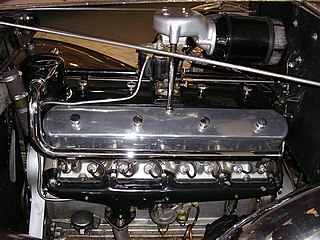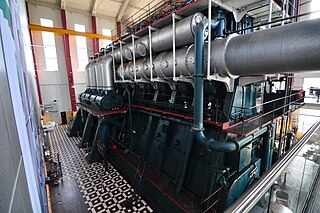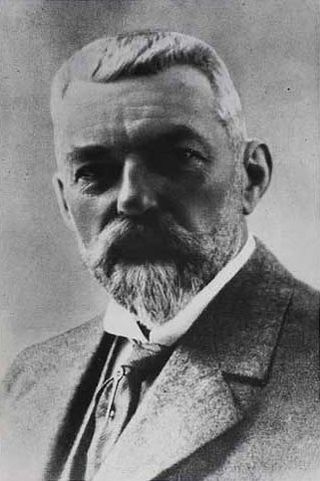Burmeister & Wain was a large established Danish shipyard and leading diesel engine producer headquartered in Copenhagen, Denmark. Founded by two Danes and an Englishman, its earliest roots stretch back to 1846. Over its 150-year history, it grew successfully into a strong company through the end of the 1960s. In the 1970s, global competitive pressures, particularly from the far east, began to take their toll. In 1980, B&W became MAN B&W Diesel A/S, part of MAN B&W Diesel Group, a subsidiary of the German corporation MAN AG, with operations worldwide. The company still maintains operations at three main sites in Denmark for manufacturing, servicing, and licensing of its two-stroke engines and complete propulsion systems.

MAN SE was a manufacturing and engineering company based in Munich, Germany. Its primary output was commercial vehicles and diesel engines through its MAN Truck & Bus and MAN Latin America divisions, and participation in the manufacturer Sinotruk.

A V16 engine is a sixteen-cylinder piston engine where two banks of eight cylinders are arranged in a V configuration around a common crankshaft. V16 engines are less common than engines with fewer cylinders, such as V8 and V12 engines. Each bank of a V16 engine can be thought of as a straight-eight, a design that can be inherently balanced. Most V16 engines have a 45° bank angle.
The straight-five engine is a piston engine with five cylinders mounted in a straight line along the crankshaft.

Power Stroke, also known as Powerstroke, is the name used by a family of diesel engines for trucks produced by Ford Motor Company and Navistar International for Ford products since 1994. Along with its use in the Ford F-Series, applications include the Ford E-Series, Ford Excursion, and Ford LCF commercial truck. The name was also used for a diesel engine used in South American production of the Ford Ranger.

The Navistar VT engine family is a line of diesel engines that was produced by International Truck and Engine from 2003 to 2016. Developed as the replacement for the T444E V8, the VT V6 and V8 diesels were the smallest diesel engines used in Navistar vehicles, slotted below the DT inline-6 engine family. Sharing many applications with the DT466 inline-6, the VT engines were used in medium-duty trucks and school bus chassis, competing against the Cummins B-series and the Mercedes-Benz MBE900 diesel engines. In 2007, both the VT and DT engines were rebranded under the MaxxForce brand name, with model designations related to their displacement.

Kongens Enghave, commonly known as Sydhavnen or the postal district of 2450 Copenhagen SV (southwest) is a district in southern Copenhagen. While its core is a largely pre-WWII former working class district, it also contains an upscale residential area along the harbour having been developed after 2000, scattered industrial areas, large parks such as Valbyparken and Sydhavnstippen, allotment gardens and parts of Vestre Kirkegård, the city's largest cemetery.

SEMT Pielstick was a French company that designed and built large diesel engines. Its full name was Société d’Etudes des Machines Thermiques.

The EMD 567 is a line of large medium-speed diesel engines built by General Motors' Electro-Motive Division. This engine, which succeeded Winton's 201A, was used in EMD's locomotives from 1938 until its replacement in 1966 by the EMD 645. It has a bore of 8+1⁄2 in (216 mm), a stroke of 10 in (254 mm) and a displacement of 567 cu in (9.29 L) per cylinder. Like the Winton 201A, the EMD 645 and the EMD 710, the EMD 567 is a two-stroke engine.

The Family II is a straight-4 piston engine that was originally developed by Opel in the 1970s, debuting in 1981. Available in a wide range of cubic capacities ranging from 1598 to 2405 cc, it simultaneously replaced the Opel CIH and Vauxhall Slant-4 engines, and was GM Europe's core mid-sized powerplant design for much of the 1980s, and provided the basis for the later Ecotec series of engines in the 1990s.

F Renault engine is an automotive internal combustion engine, four-stroke, inline-four engine bored directly into the iron block, water cooled, with overhead camshaft driven by a timing belt, and with an aluminum cylinder head, developed and produced by Renault in the early '80s, making its appearance on the Renault 9 and 11. This engine is available in petrol and diesel versions, with 8 or 16 valves.

A two-stroke diesel engine is a diesel engine that uses compression ignition in a two-stroke combustion cycle. It was invented by Hugo Güldner in 1899.

Blackstone & Co. was a farm implement maker at Stamford, Lincolnshire, United Kingdom.

Mitsui Engineering & Shipbuilding is a Japanese heavy industries company. Despite its name, it no longer builds ships and now focuses mainly on production of high-value ship equipment such as engines and automated gantry cranes.

MAN Energy Solutions SE is a German manufacturer of large diesel engines and turbomachinery for maritime and stationary applications based in Augsburg. The company develops and manufactures two-stroke and four-stroke diesel engines, as well as gas turbines, steam turbines, and compressors. MAN Energy Solutions also offers turbochargers, propellers, gas engines, and chemical reactors. Additionally, it produces ship engines that run on synthetic fuels and develops technologies for carbon capture and storage (CCS), large heat pumps, and electrolysers for the production of green hydrogen. The company employs around 15,000 people at more than 140 international locations, particularly in Germany, Denmark, France, Switzerland, the Czech Republic, India, and China.

DieselHouse is an interactive exhibition on diesel technology located on the grounds of the still operating H. C. Ørsted Power Station in the South Docklands of Copenhagen, Denmark. The exhibition is centred on a gigantic decommissioned Burmeister & Wain diesel engine which was the world's largest for more than 30 years.
The Daihatsu C-series engine is a range of compact three-cylinder, internal combustion piston engines, designed by Daihatsu, which is a subsidiary of Toyota. The engines range from 843 to 993 cc and have been manufactured in petrol and diesel-driven series. They have cast iron engine blocks and aluminum cylinder heads, and are of either SOHC or DOHC design, with belt driven heads. The engine first appeared in the all-new Daihatsu Charade in October 1977, in "CB20" form.

Ivar Peter Bagger Knudsen was a Danish engineer. As the director of Burmeister & Wain (B&W), Knudsen led the development of the MS Selandia, the biggest, most advanced diesel-powered vessel of its time.

MSC Oscar, and sister ships MSC Zoe and MSC Oliver, are large container ships. Christened on 8 January 2015, MSC Oscar was recognised as the largest container ship in the world; until then CSCL Globe, inaugurated in November 2014, had been the largest.














